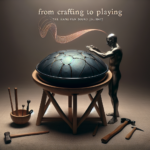In the vast realm of musical instruments, few can claim the unique allure and emotional resonance of the handpan. This steel instrument, known for its etheric, calming tones, has carved a niche in the modern music landscape. Whether it is for personal meditative practices or professional musical performances, the handpan is becoming an increasingly popular choice among musicians and listeners alike. This article delves deep into the world of handpans, examining their origins, construction, cultural significance, and the profound impact they have on contemporary music.
Origins and Evolution
The handpan is a relatively young instrument, with its roots tracing back to the early 21st century. It was first developed in Switzerland by Felix Rohner and Sabina Schärer, who were inspired by the Caribbean steel drums and the Indian ghatam. The prototype, called the Hang (pronounced ‘hung’), was introduced in 2000 by their company PANArt. The Hang quickly captured the imagination of musicians and listeners with its unique soundscape and meditative vibrations.
The design started with a simple concept: a convex steel shell with a central note and a series of tone fields. Over time, the instrument evolved, and variations sprouted across the world, leading to the generic term ‘handpan’ that is now widely used. Today, numerous makers craft handpans, each adding their unique flair and innovations to the instrument’s design and tuning.
Sound and Construction
One of the most captivating aspects of the handpan is its sound. When struck gently with the hands, the handpan emits a rich, resonant tone that vibrates with harmonious overtones. This creates a serene and almost otherworldly auditory experience. The instrument typically features a central note, known as the ‘ding,’ surrounded by a series of other notes arranged in a circle.
The construction of a handpan is a meticulous process. It starts with a sheet of high-grade steel, which is carefully shaped into a convex shell. The tone fields are then meticulously hammered into the surface, a process that involves both precision and an intimate understanding of acoustics. The final step involves tuning each note to ensure coherent harmonics and a balanced sound.
Cultural Impact and Usage
Handpans have transcended their initial role as musical instruments to become cultural symbols of peace, tranquility, and introspection. They are often associated with spiritual practices, yoga sessions, and holistic healing environments. The instrument’s tranquil tones are believed to facilitate emotional healing, meditation, and relaxation.
In the contemporary music scene, handpans are finding their way into a variety of genres. From ambient and world music to jazz and electronic, the versatility of the handpan enables it to blend seamlessly into diverse musical styles. Artists around the globe are experimenting with handpans, creating intricate melodies and harmonies that captivate audiences.
Learning and Playing the Handpan
Playing the handpan requires a combination of rhythm, touch, and an ear for harmony. While there are no rigid rules, a basic understanding of musical scales and rhythm can be beneficial. Many enthusiasts start with tutorials available online, and formal lessons are also becoming more common as the instrument gains popularity.
Handpans are tactile instruments, meaning players use their hands and fingers to produce sound. The playing technique involves striking the tone fields in various ways to produce different pitches and textures. The intuitive nature of the instrument allows for a personal connection between the player and the handpan, often leading to deeply expressive performances.
Challenges and Maintenance
Despite their durable appearance, handpans are surprisingly delicate instruments. They require careful handling and maintenance to preserve their sound quality. Factors like humidity, temperature, and physical impact can affect the tuning and lifespan of the instrument. Regular cleaning and proper storage are crucial to ensure longevity.
Another challenge is the price. High-quality handpans can be quite expensive, often costing several thousand dollars. This is largely due to the intricate craftsmanship and labor-intensive process involved in their creation. However, many enthusiasts find the investment worthwhile, given the handpan’s unique musical qualities and emotional benefits.
Conclusion
The handpan is more than just a musical instrument; it is a medium for emotional expression and spiritual connection. Its soothing tones and versatility have made it a beloved choice for contemporary musicians and listeners seeking tranquility in a fast-paced world. As the handpan continues to evolve, it promises to enrich the musical landscape with its unique and harmonious voice, captivating hearts and minds across the globe.
FAQs
- 1. What is the difference between a handpan and a Hang?
- The term “Hang” specifically refers to the original instrument created by PANArt in Switzerland. All similar instruments developed later by various makers are generally referred to as handpans.
- 2. How long does it take to learn to play the handpan?
- The time it takes to learn the handpan varies from person to person. Basic melodies and rhythms can be learned within a few weeks, especially with regular practice. However, mastering the instrument and developing a personal playing style can take years.
- 3. Can handpans go out of tune?
- Yes, handpans can go out of tune due to factors like temperature changes, humidity, and physical impacts. Regular maintenance and proper storage can help mitigate these risks and prolong the instrument’s tuning stability.
- 4. Are handpans only suitable for meditative music?
- While handpans are popular in meditative and ambient music genres, they are quite versatile and can be used in various musical styles, including jazz, world music, and even electronic music.
- 5. Why are handpans so expensive?
- The high cost of handpans is primarily due to the labor-intensive crafting process, the quality of materials used, and the skill required to create and tune them. Each handpan is often handcrafted, contributing to its uniqueness and value.





